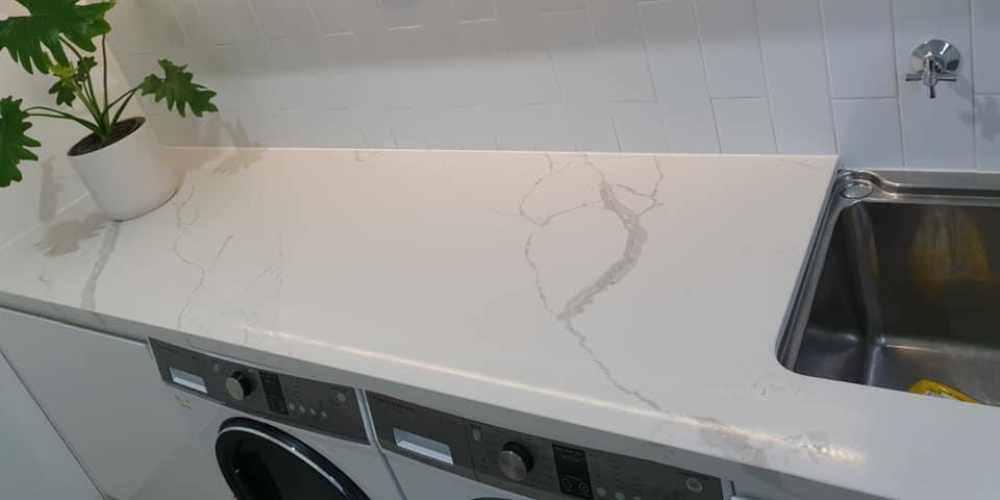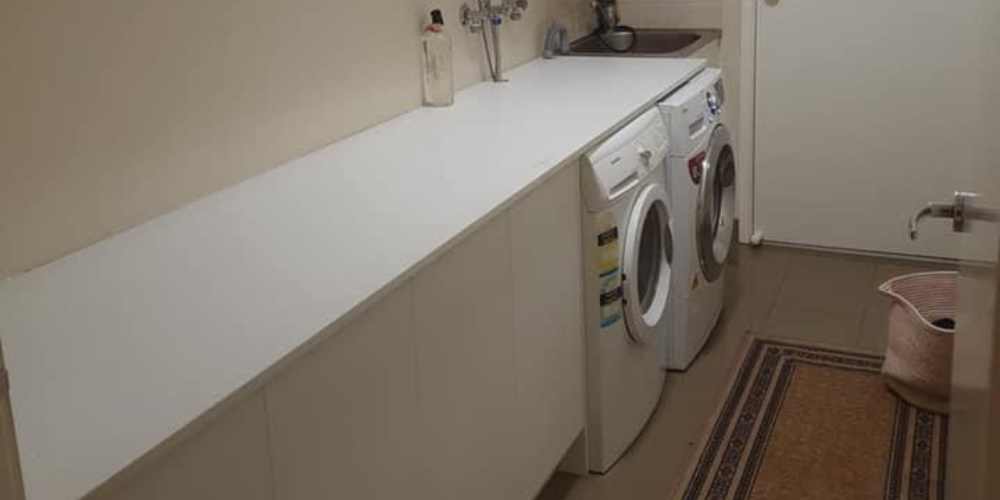Choosing the Right Flooring for Your Laundry Room Renovation
We all want our laundry rooms to be more than simply a place to wash, right? It’s where the magic happens when loads of clothing go in and come out clean and fresh. So, if you want to renovate your laundry room, you’ve come to the right place!
Imagine a laundry room that does the job and looks great. You have the comfort, usefulness, and a dash of flair. Aside from the excitement of choosing the layout, appliances, and lighting, you must also pay attention to one critical factor: the flooring.
Yes, you heard right. The flooring in your laundry area is a game changer. It’s not only about choosing something that looks beautiful (though important, too! ) but also about choosing flooring that can withstand all spills, splashes, and foot activity. It would be best to have something long-lasting, moisture-resistant, and simple to care for.
No more stepping on cold, hard surfaces or being concerned about flooding. It’s time to design a laundry room that will make you happy every time you enter it and make doing laundry seem easy.
Read on and find the best flooring design for your ideal laundry area.
Let’s begin!
Why is Having the Right Flooring for Your Laundry Important?
Having the correct flooring in your laundry room is more important than you realize. It is not only an appearance issue; it also directly influences the overall comfort, usefulness, and longevity of the space. Let’s dissect it:
Comfortable Work Environment
Laundry day can be a tremendous pain, and the correct flooring may make all the difference. Consider standing for hours on a cold, hard surface, sorting, folding, and ironing garments. The correct flooring may give a more forgiving and pleasant surface, making laundry more enjoyable.
Handles Spills and Splashes
Spills and splashes are common in laundry rooms, whether from detergent spills, water leaks, or fabric softener incidents. Moisture-resistant flooring will help avoid water damage and keep your laundry room looking great for years.
Heavy Use Durability
Laundry rooms are high-traffic places, especially in large families. The flooring must be robust enough to withstand regular wear and tear, from pulling laundry baskets to lifting large appliances, without indicating damage.
Easy to Maintain
We’d all like a low-maintenance laundry room, don’t we? Choosing flooring that is simple to maintain and does not require frequent maintenance can save you time and effort in the long term. Nobody wants to spend more time washing laundry than cleaning the floors!
Aesthetic Appeal
While the utility is critical, let us not overlook beauty. The appropriate flooring may improve the overall appearance of your laundry room, connecting the entire area with the decor and style you’ve chosen.
Resale Value
Whether you want to stay in your existing house or eventually sell it, the perfect flooring may increase the market value of your property. A well-designed and functioning laundry room is an important selling factor for potential buyers.

Characteristics of a Good Laundry Flooring
A good laundry room flooring should have many essential characteristics that make it ideal for the space’s needs. Here are the key characteristics to look for in laundry room flooring:
Moisture Resistance
Laundry rooms are frequently exposed to water due to washing machines, accidents, and leaks. Moisture-resistant flooring, such as ceramic tiles or waterproof luxury vinyl planks, keeps your flooring intact and secure by preventing water damage, warping, and mold growth.
Durability
Long-lasting flooring material is required, given the high foot traffic and continual movement of heavy laundry baskets and appliances. Choose durable materials such as porcelain tiles or laminate flooring that can withstand everyday wear and tear while maintaining aesthetic and structural integrity.
Simple to Clean and Maintain
Given the prevalence of soap splatters and lint collection in laundry rooms, a flooring material that is easy to clean and needs little care is perfect. Smooth surfaces, like vinyl or linoleum, provide easy cleanup, saving you time and effort to keep your room neat.
Resistance to Stains
Accidents happen, and laundry rooms are no exception. Stain-resistant flooring, such as porcelain tiles or sealed concrete, can guard against detergent, bleach, or fabric softener spills, ensuring your flooring remains blemish-free and flawless.
Comfort and Ergonomics
Standing for extended periods while doing laundry can be taxing and uncomfortable. To improve comfort, consider flooring with cushioning, such as cork or rubber. These materials offer a more forgiving surface and lessen the stress on your feet and legs.
Non-Slip Surface
In a laundry room that could become wet, safety should come first. To avoid slips and falls, especially on wet floors, choose a flooring material with a non-slip surface, like textured tiles or luxury vinyl planks.
Aesthetics and Design
While practicality is important, your laundry room’s flooring should enhance its visual appeal. Think about colors, textures, and patterns that go well with the decor you want to achieve in the area to make it cohesive and aesthetically pleasing.

Types of Flooring Best for Your Laundry Room
When choosing the ideal flooring for your laundry room, many options are available that are well-suited to fulfill the special needs of this high-moisture and high-traffic space. Here are some of the best flooring options for laundry rooms:
Ceramic or porcelain tiles
Advantages:
Porcelain or ceramic tiles are popular in laundry rooms because of their outstanding durability, water resistance, and stain resistance. These tough fabrics can withstand considerable foot traffic, spills, and splashes without deterioration. Because of their simplicity of upkeep, they are a practical and sanitary choice for laundry room flooring.
Disadvantages:
While the practicality of tiles is noteworthy, homeowners should be mindful that they might be chilly underfoot. To improve comfort, consider using radiant heating or strategically placing area rugs.
LVP (Luxury Vinyl Planks)
Advantages:
Luxury Vinyl Planks (LVP) provide an excellent blend of durability, waterproofing, and beauty. Their scratch-resistant surface keeps them in perfect condition even when subjected to rigorous laundry room activity. The variety of design possibilities allows homeowners to mimic the look of hardwood or real stone without the accompanying upkeep issues.
Disadvantages:
Choosing 100% waterproof LVP ensures comprehensive moisture protection, protecting the laundry room from water-related hazards.
Sheet Vinyl
Advantages:
Sheet vinyl is a low-cost alternative with exceptional water resistance and comfort. Its smooth installation reduces possible water infiltration spots, improving the flooring’s overall water resistance. The variety of patterns and colors allows for artistic expression in laundry room decor.
Disadvantages:
It is critical to ensure correct installation to eliminate seam-related risks. A professionally placed sheet vinyl floor has the potential to deliver long-term durability and performance.
Vinyl Flooring
Advantages:
A practical option, rubber flooring is renowned for its exceptional water resistance and longevity. This flooring choice makes standing for long periods while doing laundry more bearable. It is an excellent option for high-traffic laundry facilities because of its durability against wear and tear.
Disadvantages:
Even though rubber flooring is quite useful, some homeowners might choose different materials because of their aesthetic appeal.
Linoleum
Advantages:
With exceptional water resistance and a variety of pattern options, linoleum stands out as an ecologically beneficial choice. Eco-conscious residents are drawn to it because of its natural makeup and renewable resources. Linoleum may remain a dependable flooring option for laundry rooms if maintained regularly and sealed properly.
Disadvantages:
You should consider the necessity of routine upkeep and occasional sealing to maintain linoleum’s water resistance over time.
Concrete
Advantages:
Concrete floors have great strength and natural resistance to water. Its adaptability enables customization through staining or sealing, giving laundry facilities a modern and industrial feel. Concrete flooring that has been properly handled can provide laundry rooms with long-lasting functionality.
Disadvantages:
In high-traffic areas, the hardness of concrete could need rugs or mats to improve user comfort.
Laminate Flooring
Advantages:
For laundry rooms, laminate flooring is a useful and affordable solution. Laminate flooring is the perfect choice for busy laundry rooms because of its strength and simplicity of maintenance. Homeowners are certain to discover a style or design that goes well with their interior décor thanks to the range of available options.
Disadvantages:
Even if certain laminates are water-resistant, it is still important to use caution when exposing the flooring to a lot of moisture to preserve its functionality.
Tips When Choosing Laundry Room Flooring During Renovation
There are several crucial considerations to remember when choosing the flooring for your laundry room to make the best decision. The following are some essential reminders:
Prioritize Moisture Resistance
Moisture resistance is crucial since laundry rooms are prone to spills, leaks, and high humidity. Choose flooring materials that resist water exposure without warping or degrading, such as porcelain tiles, luxury vinyl planks (LVP), or sheet vinyl. The right level of moisture resistance guarantees the longevity of your flooring. It stops mold or mildew from growing in this often damp area.
Choose Durable Materials
There is a lot of foot activity in laundry rooms, and heavy appliances and wash baskets are frequently moved. By selecting durable flooring materials like ceramic tiles, rubber, or concrete, you can guarantee that your flooring can withstand the rigors of everyday usage without displaying signs of wear and tear. Long-lasting performance is provided by durable flooring, which not only preserves its attractiveness but also lengthens its lifespan.
Consider Comfort and Ergonomics
When choosing flooring for laundry duties, put comfort first because standing for a long time is required. Better ergonomic support is provided by materials like rubber or cork, which lessens stress and tiredness on your feet and legs. Making laundry day more joyful and less physically demanding can be achieved by installing flooring in the ergonomically friendly laundry room.
Choose Non-Slip Surfaces
Safety should always be a priority, especially in areas where water spills are frequent. Use flooring materials with a non-slip finish to lessen the chance of slips and falls. Rubber flooring, LVP with slip-resistant coatings, and textured tiles are all great choices that give more grip even when the floor is wet, giving you and your family a stable footing.
Determine Maintenance Needs
The upkeep requirements of various flooring materials differ. Consider your lifestyle and how much time you will spend maintaining and cleaning. While some materials, such as luxury vinyl planks, laminate, or linoleum, are simple to clean and need little upkeep, others could require more frequent maintenance. Long-term time and effort savings can be achieved by selecting a low-maintenance flooring solution.
Create a Budget
You must set a budget for your laundry room flooring, just like any other home improvement job. The cost of various flooring materials varies, so setting a budget in advance will help you limit your alternatives. Choose a flooring option that satisfies your demands without exceeding the budget by establishing a reasonable budget.
Frequently Asked Questions
Dark countertops keep spills and finish imperfections hidden, maintaining the aesthetic appeal of your kitchen. They maintain a consistent theme across the house and a neutral attitude. Additionally, well-lit kitchens with dark surfaces look great. For visitors, they make the kitchen appear hospitable and cozy.
When it comes to durability, quartz comes out on top. This artificially created stone countertop has a surface that mimics real stone and is made of crushed quartz stone blended with polymers and resin.
Another excellent choice is quartz countertops. If you don’t like white, use a neutral color like tan, beige, or ivory. For a more durable appearance, use subtle veining and a discreet design.
Solid surface counters are incredibly adaptable and provide granite and engineered quartz a realistic and significantly less expensive substitute. Additionally, solid surface counters are relatively easy to keep clean.
Conclusion
It’s important to consider several aspects when selecting the ideal countertop for your kitchen renovation, including your budget, durability, maintenance requirements, design and aesthetics, and practicality. You can make an informed choice by deciding on your priorities, budget, kitchen design, and aesthetics, figuring out how much upkeep you’re prepared to put out, and evaluating the countertop’s usefulness.
Choosing the perfect countertop for your kitchen renovations can be a challenging task. Still, by following these easy rules, you can simplify the process and guarantee that you pick the best option. Remember to think about everything essential to you and spend time researching the many varieties of countertops available. You can change your kitchen into a beautiful and useful environment that you and your family will enjoy for years with the appropriate countertop.
Like this article?
